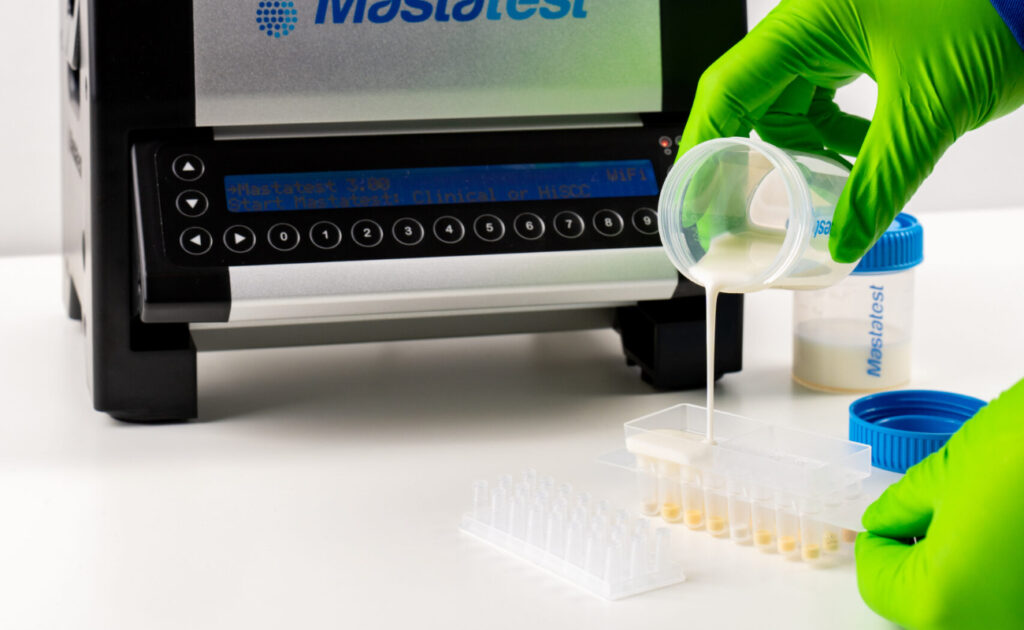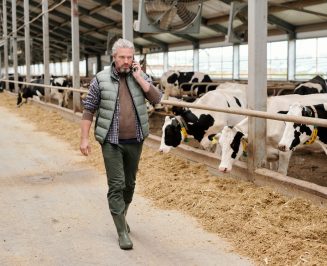Easily monitor and treat clinical and subclinical mastitis with confidence.



Easy to use
"Set and forget" the test, whether in practice or on the farm.
Fast results
Results automatically reported to farmer and veterinarian
Flexible for clinical or subclinical mastitis
Bacterial identification and antimicrobial susceptibility
Automated records
of all test results for analysis and better decision-making
Vet-controlled interface
Specific interface and control of treatment recommendation


Clinical and subclinical mastitis therapy just got easier and less stressful
What Mastatest does:
- Mastatest is the mastitis diagnostic tool that provides all information you need to make the right decisions for your herd.
- Know exactly which bacteria are causing infection within just 24 hours!
- Simplify udder health management with tailored antibiotic response, whether it’s a first episode or relapse.
Mastatest is a convenient diagnostic solution for clinical mastitis that identifies mastitis-causing pathogens and antibiotic susceptibility to help you decide which animals need treatment and which don’t, all within 24h! Test results and recommendations are automatically reported via the cloud-based platform.
For testing clinical mastitis cases use Mastatest Clinical Cartridges.
Mastatest HiSCC enhances mastitis management with automated, on-farm bacterial identification within 24h, enabling precise treatment and mastitis management. By targeting cows with high Somatic Cell Counts (SCC) and identifying the responsible bacteria, you reduce unnecessary antibiotic use and minimize production losses, ensuring healthier udders. Mastatest HiSCC test cartridges are only for testing cows with high SCC.
6 Reasons to Choose Mastatest for Mastitis Management
Properly identifying the mastitis bacteria and reviewing the cow’s mastitis history helps with:
Targeted treatment
Responsible use of antibiotics
Reducing mastitis
Management decisions
Reducing SCC
Increased profitability
What’s included in the Mastatest solution
3 Key Tools to Strengthen Veterinarian-Farmer Partnerships
Mastatest is a completely new approach to in-practice and on-farm mastitis diagnostic. It includes a connected analyser (Lapbox™), test cartridges, and access to a cloud-based web platform.
See how it works for clinical mastitis and subclinical mastitis.
1· Analyzer / Lapbox
2· Test cartridges
3· Cloud based web plateform
Smart Udder Health Management
Begins With Mastatest
Mastatest is available in select countries around the world.
Please get in touch with our Sales team to find out more and get your Mastatest.

You can also call our team
Dedicated mastatest phone lines for installation and after-sales support:
They’re Using Mastatest to Improve Mastitis Management
Doctor Olivier Salat, farm vet, and Mathilde Challier, a dairy farmer in the Cantal region of France,
talk about using Mastatest to make confident decisions for every cow.
Your Questions, Answered
All You Need to Know About Mastatest For Better Mastitis Management & Decision-Making
Mastatest is an easy-to-use mastitis diagnostic tool that helps you make informed mastitis management decisions.
By automating the diagnostic process, the Mastatest system eliminates all constraints associated with milk analysis. There’s no need for transport, and results are sent directly to your inbox within 24 hours.
Mastatest gives you all the information you need to make confident decisions for every cow. The results tell you whether or not bacteria are present, what species of bacteria are present and what their sensitivities are to the antibiotics tested.
With these comprehensive results provided for every cow tested, you can identify cows that don’t need antibiotic treatment, and improve cure rates for those that do by targeting treatment. This reduces the time cows spend out of the herd and the amount of milk discarded. Historical data on individual cows and the herd as a whole also enable more informed herd management decisions.
Mastatest uses electronic eye technology to automatically detect color changes caused by bacterial species present in the milk sample.
All you have to do is collect a milk sample, fill in a cassette and run the test. The analyzer does the rest.
The data collected by the analyzer is automatically analyzed and interpreted by an algorithm on a cloud, and the results are sent to your inbox within 24 hours and are also accessible via a web platform dedicated to storing them.
For tests performed on a clinical cassette, you will receive information concerning :
Presence (or absence) of bacteria
The bacterial species present. The species identified are Streptococcus uberis, Streptococcus dysgalactiae, Streptococcus agalctiae, Staphylococcus aureus, coagulase-negative Staphylococcus (Staphylococcus nonaureus) in the case of Gram-positive bacteria. Identification of Gram-positive bacteria does not give a precise indication of the bacterial species.
An evaluation of the minimum inhibitory concentration (MIC) of three key antibiotics: benzylpenicillin, cloxacillin and tylosin in the case of sensitivity, and the results show resistance if no antibiotic has an inhibitory effect on bacterial growth.
All you’ll need to run the Mastatest system is :
A WiFi or ethernet connection (at least – 65dBm signal strength – indicated on the display)
A standard electrical connection
A refrigerator for cassette storage
Initial setup takes just a few minutes, thanks to the simple instructions supplied with the Lapbox™.
Vetoquinol will walk you through the process and get you ready to process your first samples with an installation and IT support manager.
As far as running a test is concerned, it’s so simple that anyone can do it, regardless of qualification or training.
As for interpreting the results, this has to be done by the veterinarian in order to recommend the right treatment.
However, we recommend that any staff member taking a milk sample should be trained in this procedure.
There are two ways to launch an analysis.
The essential step, whichever method you use, is as follows: Via the platform, create the customer account (operation) to which the analysis will be linked.
First method: Launch a test from the analyzer
1) Access the Mastatest menu.
2) Go to Launch Mastatest.
3) Select the desired location.
4) Enter cow information (cow number and quarter).
5) Validate information and launch test.
6) Insert the cassette filled with your milk sample into the previously selected slot.
7) Access the platform and launch the test at the location concerned, assigning the sample to a farm.
Second method: Launch a test from the platform
1) Access the Mastatest menu from the analyzer.
2) Press the thumbwheel 4 times in succession (this will launch the test without personalizing the cow number and the quarter from which the milk sample is taken).
3) Insert the cassette filled with your milk sample into the previously selected slot.
4) Access the platform.
5) Run a test at the location concerned, entering the cow information (cow number and quarter) and assigning the analysis to a farm.
N.B.: For both methods, you can either go through the analyzer first or the platform.
There may be a delay of around 10 min (or even 15 min, depending on the quality of your Internet connection) between the launch on the platform or the analyzer and the algorithm’s taking into account of the latter to interpret the results.
There are two easy ways to access Mastatest results.
By e-mail: You will receive Mastatest results in your e-mail inbox. You can add several e-mail addresses to the system, so that everyone involved in the decision-making process receives a copy.
Mastatest web interface: You and your team can access Mastatest results directly from the data console, using the website. The data console contains your herd’s historical results, allowing you to review previous results for each cow before making mastitis management decisions
The Mastatest system provides digital results back to your inbox within 24 hours of starting a Lapbox™ test.
Yes, Mastatest can be used to test samples from cows with clinical mastitis.
Use the clinical cassette for clinical mastitis. After taking a milk sample from the affected cow, simply fill the cassette, place it in the analyzer, and run the test.
In less than 24 hours, you’ll have information on the presence or absence of bacteria in the sample, their type: E. coli, Klebsiella, Streptococcus uberis, Streptococcus dysgalactiae, Streptococcus species, Staphylococcus aureus, coagulase-negative Staphylococcus (Staphylococcus non-aureus) and other Gram-positive bacteria, and the bacteria’s sensitivity to the various antibiotics.
Antibiotic selection will include: benzylpenicillin, cloxacillin and tylosin.
By systematically testing cows suffering from clinical mastitis, you ensure you have all the information you need to inform your mastitis management. Ultimately, this should lead to improved cure rates, reduced time away from the herd for affected cows and better milk productivity.
There is no synchronization, but the test cycle should continue to download images once internet connectivity is working again. If 2 or 3 hours are missing, this is usually not a problem, unless it’s the last 4 hours of the test cycle.
It also depends on when the cycle is interrupted. If the analysis has sent an initial image and the last two images, the test can be evaluated. If, however, the interruption occurs, for example, within the last 12 hours, a notification is given that more images are required before the test can be evaluated. Instructions are provided to the end customer.
Studies have shown that waiting 24 hours to confirm the presence (and species) of bacteria in a milk sample before treating with antibiotics is an appropriate course of action for most cows with mild to moderate mastitis.
Up to 25% of cows may have mastitis with no bacterial cause, which should heal without further treatment. Mastatest can identify these cows for you.
Up to 25% of cows with Gram-negative bacteria such as E. coli in the milk do not require antibiotic treatment.
In the case of a cow with severe mastitis and who is seriously ill, antibiotic treatment must be started immediately and can be adapted after receiving bacteriology results.
number of analyzers you need will depend on the rate of mastitis on the farm, and therefore on the number of samples you are likely to take in a 24-hour window.
Each Lapbox can process up to four samples at a time, i.e. 365×4 = 1460 samples per year.
A simple rule of thumb is that a Lapbox should be able to analyze milk samples from a herd of around 1500 cows.
Antibiotic susceptibility test results are likely to display “s.o.” in the following cases:
– the sample taken is sterile
– the sample contains two or more germs (in the case of polycontamination, for example).
The display “”n/a”” simply means that the antibiogram results cannot be used.
In the case of a sterile sample, the 3 molecules benzylpenicillin, cloxacillin and tylosin have no effect, since no germs were detected in the milk sample used for bacteriological analysis.
As the analyzer cannot quantify one bacterial population in the majority compared with another, the potential effects of the 3 different antibiotics cannot be assigned to one of the two bacteria in the case of a sample containing two germs. The same applies to a polycontaminated sample containing 3 or more germs.
